One of the reasons the core of Batman’s rogues gallery has proven so lasting is the fact that many of his foes are super-functional storytelling devices. The Joker is a clown, so he always looks scary. The Riddler has a puzzle-compulsion, so he always provides mysteries for the Dynamic Duo to solve. Two-Face has a split personality and that coin toss thing, so he’s ideally suited for tales about free will, luck, and duality. With Poison Ivy, there’s the blatant eco-sexual symbolism.
Similarly, the Scarecrow’s modus operandi conveniently consists of spraying people with a fear-inducing gas, which a) easily allows writers to explore the subconscious of various characters, and b) can serve as a good pretext for artists to go wild, drawing freaky hallucinations. Several comics have taken advantage of this… Most memorably, Nightwing #9-10 features a lengthy, trippy Freudian vision full of callbacks to Dick Grayson’s backstory. I also have a soft spot for the Black & White short ‘Fear is the Key’ (originally published in Gotham Knights #37), which blurs the line between reality and delusion in an awesome way.
With that in mind, let’s take a closer look at how different creative teams explored the potential of Scarecrow’s gimmick…
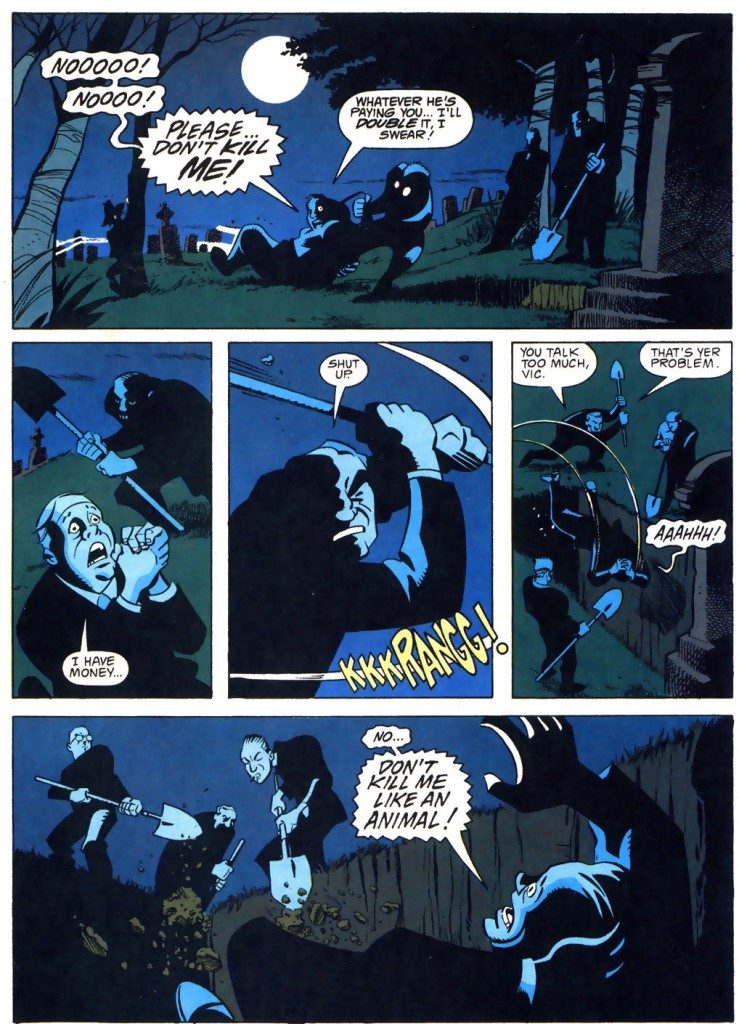
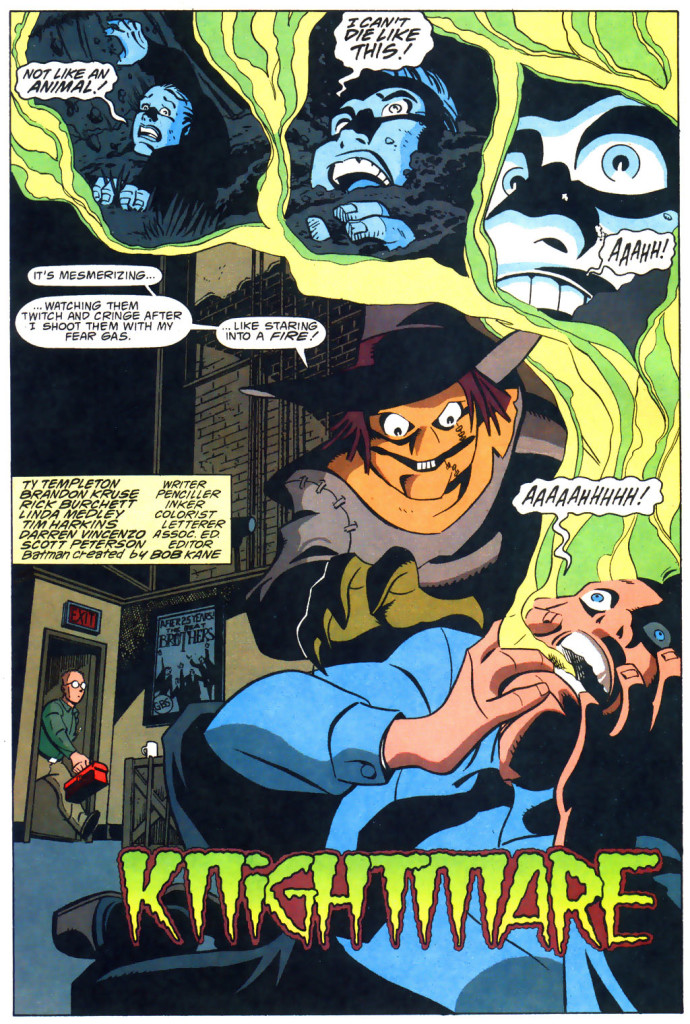 Batman & Robin Adventures #13
Batman & Robin Adventures #13
By starting ‘Knigthmare’ (Batman & Robin Adventures #13, cover-dated December 1996) inside a Scarecrow-induced hallucination and only revealing this in the second page, writer Ty Templeton opens the proceedings with a nifty twist while quickly setting up how the whole fear gas thing works. The brisk pace, efficient storytelling, and accessibility are all hallmarks of the series and this issue doesn’t disappoint.
Penciller Brandon Kruse, inker Rick Burchett, and colorist Linda Medley pack a lot into each page. They do a stellar job with the shadowy cemetery scene (you can even glimpse the Scarecrow’s silhouette hiding in the first panel) as well as with the intoxicated security guard’s bug-eyed expression. The gassy, brightly noxious green-yellow panel borders in the transition to the ‘real’ world guide your eyes down to the horrific title, at the bottom. The artists also sneak into the background Scarecrow’s accomplice, Michael Friday, casually walking into the room, thus establishing his personality through the lack of empathy with the screaming victim (his last name, which we find out in the next panel, is probably a nod to the fact that this is the thirteenth issue, thus paying homage to the horror franchise Friday the 13th). Moreover, you can see a poster for the ersatz-Beatles reunion that will drive the plot (not the first time that Batman and Robin had an adventure based on The Beatles). Finally, letterer Tim Harkins deserves praise for giving the guard’s word balloons a truly panicked feel.
‘The Sinister Straws of the Scarecrow’ (Batman #296, cover-dated February 1978) also begins by introducing the concept of the fear gas, as the disgraced professor Jonathan Crane explains its properties to his henchmen – a couple of former students who obediently fulfil their assigned tasks and are appropriately called ‘Strawmen:’
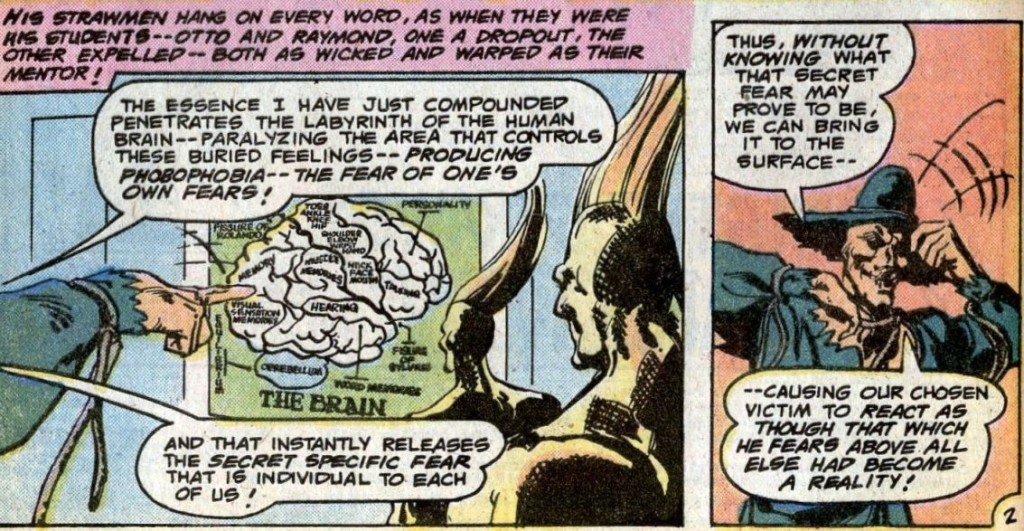
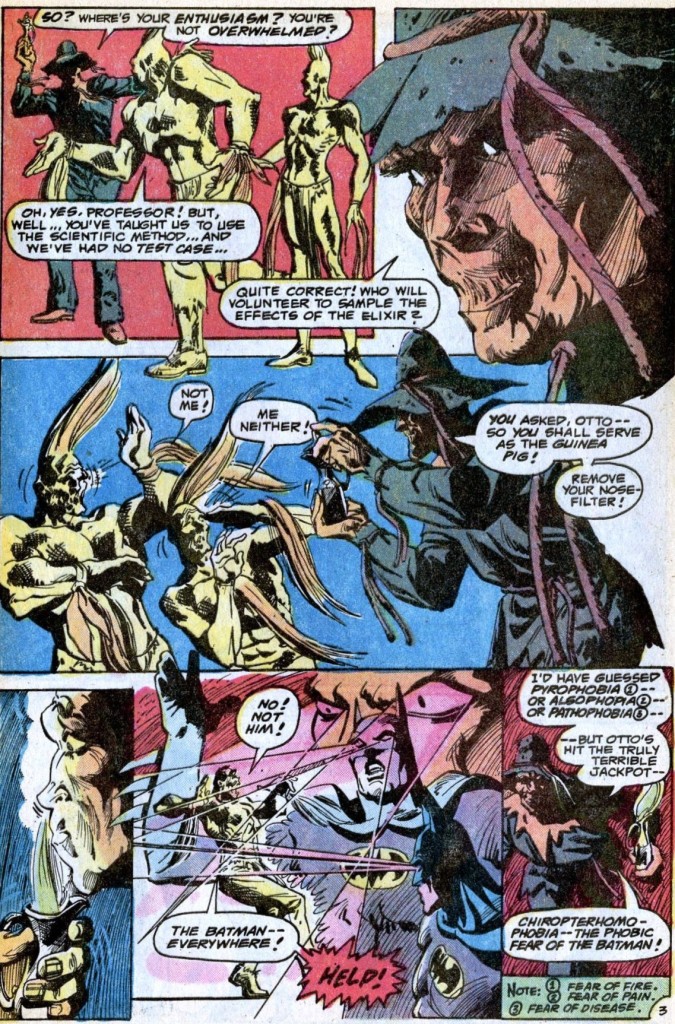
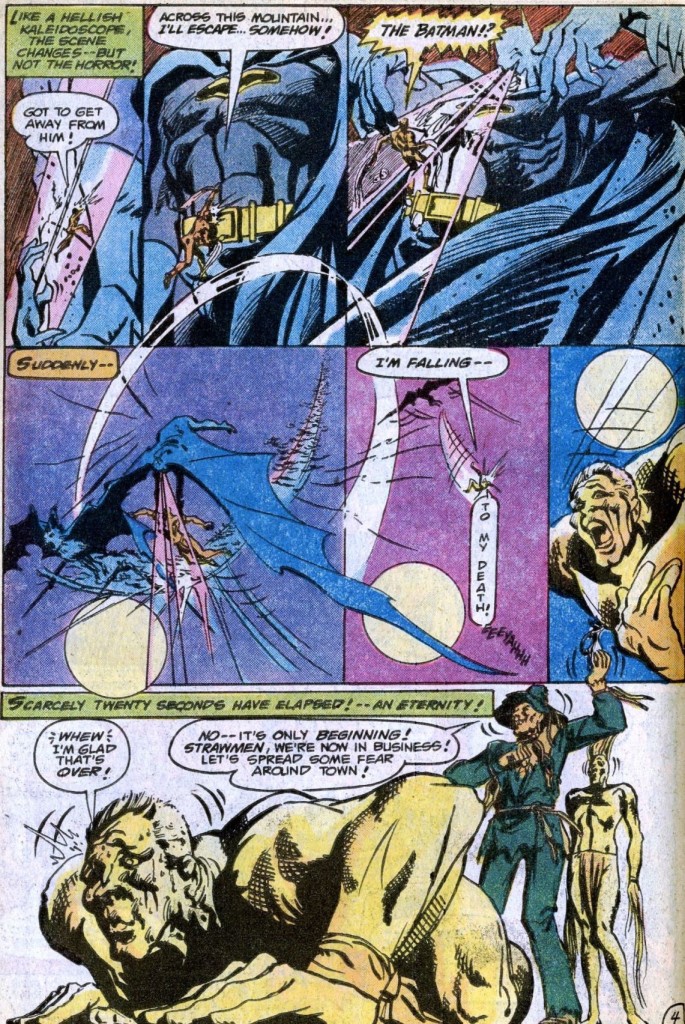 Batman #296
Batman #296
You can tell this story was written by David Vern (as David V. Reed) because of the way the Scarecrow – aka ‘the Malevolent Merchant of Heartquake’ – keeps mentioning interesting factoids, whether about the human brain or the technical names of various phobias. Vern doesn’t clutter the comic with text, though, encouraging artist Sal Amendola to indulge in surrealism by confronting one of the henchmen with his biggest fear – the fear of being attacked by a godlike Dark Knight who shoots lasers out of his eyes and is able to transform into a giant bat! Jerry Serpe contributes to the psychedelic vibe by coloring that section with a garish combination of blue, purple, and yellow. Letterer Milt Snapinn joins in on the disorienting action not only by throwing a vertical word balloon into the mix, but also by having the Strawman’s scream fall out of that balloon.
(And this is only the beginning of an all-around fun issue, which includes further hallucinations, a snitch whose underworld slang is so intricate that it requires translation, Batman solving a mystery by looking at a floor plan, and a climax with the Caped Crusader reasoning himself out of fear!)
Our final example comes from ‘Mistress of Fear’ (New Year’s Evil: Scarecrow, cover-dated February 1998), in which Jonathan Crane tortures the plucky undergrad Becky Albright – who dared testify against him – by having her experience all the classic phobias in quick succession:
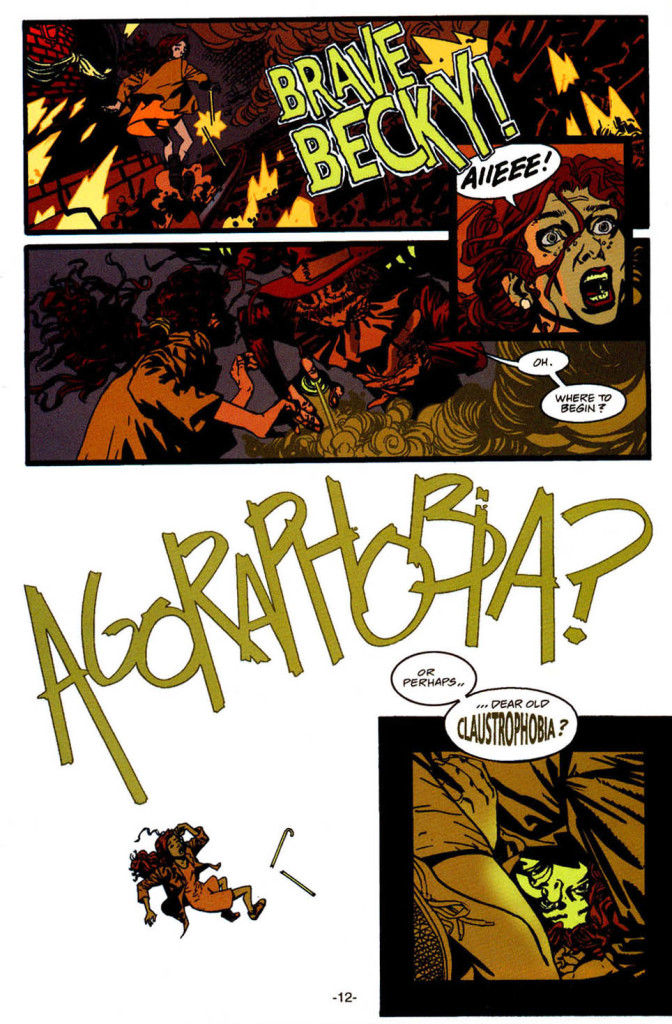
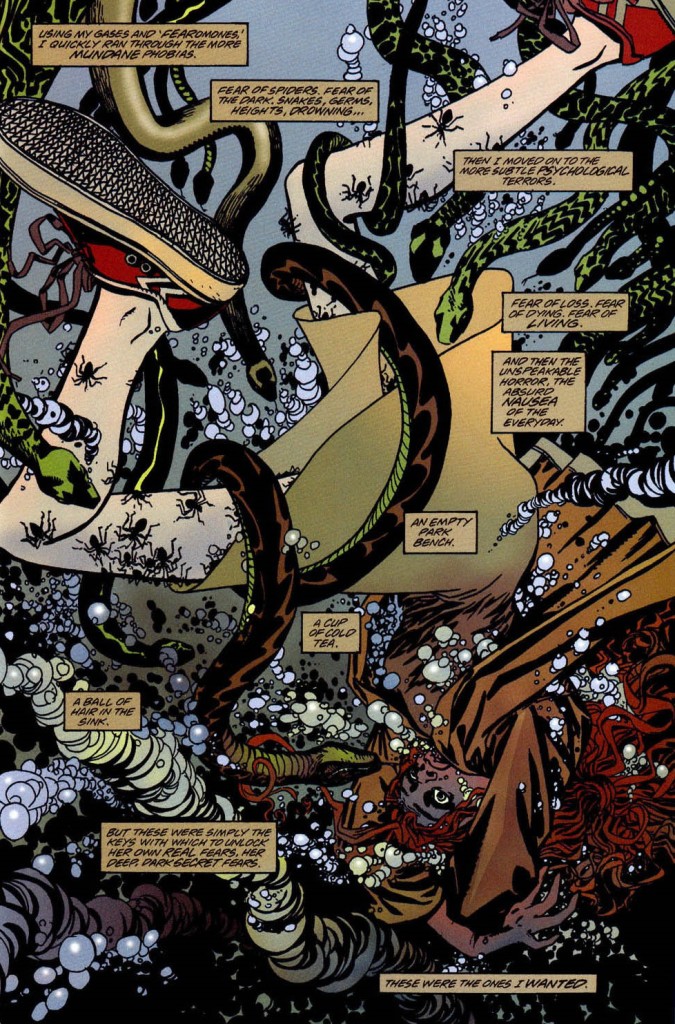
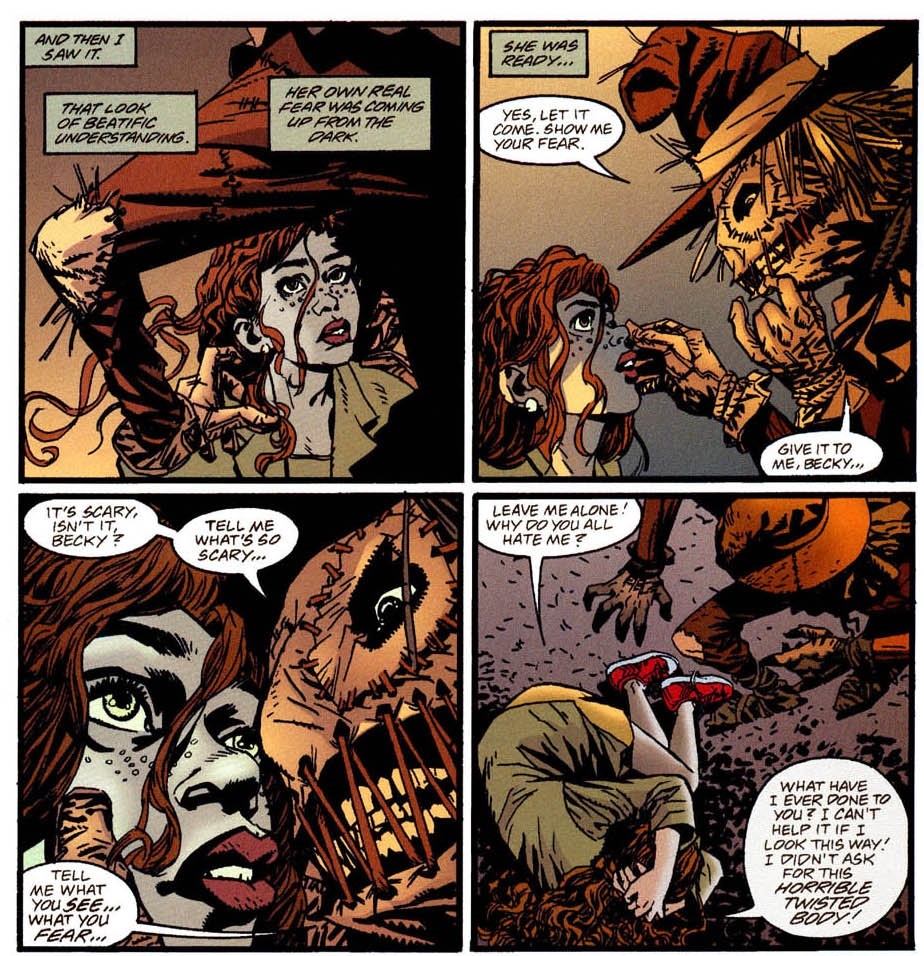 New Year’s Evil: Scarecrow
New Year’s Evil: Scarecrow
Duncan Fegredo’s art makes it so that the fears are illustrated not just by the individual images, but also by the overall layout. For agoraphobia we get Becky in a borderless panel full of negative space, signifying the unleashed fear of open places. For claustrophobia we get Becky in a clustered panel, with thick black borders, in line with the fear of closed confines. Colorist Bjarne Hansen lays on the toxic green motif. Letterer Albert de Guzman fittingly shifts the words’ fonts and sizes: the word ‘Agoraphobia?’ takes up a lot of space, the word ‘claustrophobia’ seems to be trying to break out of its balloon. The splash page in the middle shows all the fears blending into one huge panic attack, as Becky drowns in the dark while getting entangled with snakes and spiders. Her position suggests both falling *and* sinking. The last page in this sequence returns us to ‘reality,’ but it’s mostly framed with close shots, so that we continue to feel Becky’s exasperation at the wave of terror closing in on her.
Because the issue was written by an inspired Peter Milligan, it’s quite witty and cleverly constructed. After amusingly digging through both larger existential angst and mundane situations that can trigger anxieties (‘An empty park bench. A cup of cold tea. A ball of hair in the sink.’), the Scarecrow shockingly realizes that Becky’s main trauma concerns being hated because her body didn’t fit society’s standards of beauty. It’s a powerful moment, not least because this is such a recognizable fear for a young woman to have. The realization strikes a chord within Crane, himself a victim of bullying, throwing the story in a new direction.
These are just three examples. The Scarecrow has given us plenty of cool comics so far and I suppose there are many more to come. After all, his fear gas should continue to provide engaging stories as long we live in a terror-filled world driven by stress and social anxiety.
NEXT: Sarah Essen Gordon.

Most apropos for the time of year, but I’m afraid I’ve never been too big on the good Professor Crane. At first glance, his gimmick seems like an instant winner (and indeed, short of Ra’s al-Ghul and maybe the Joker, he’s easily the least-mocked of Batman’s villains), but nine times out of ten it leaves me cold. And really, I think it says something that he pops up in group efforts all the time, but rarely headlines any story that goes longer than two issues.
Scott Tipton (of the Comics 101 column – now defunct but I’m pretty sure it’s somewhere on the Wayback Machine…) theorized that the Scarecrow never rose above B-list because his gimmick is actually a pretty bad fit for the comics medium. When everything is frozen into cold, hard newsprint, the reader controls all the pacing, and jumpscares become all but impossible. And ninety percent of the time, that’s all his fear-gas attacks boils down to – jumpscares. Turn the page and it’s all over.
(That said, the remaining ten percent are legitimately awesome, *especially* that sequence from Nightwing #9-10. I never thought I’d be likening Chuck Dixon & Scott McDaniel to Neil Gaiman, but damn if that’s not the closest I’ve ever seen a mainstream superhero book get to Sandman levels of unsettling.)
This, perhaps, is why the good professor has found his greatest success in more… immersive mediums. BTAS’ “Dreams in Darkness” remains a decently-beloved classic, while the Arkham games have probably given his reputation a bigger boost than fifty whole years’ worth of comics. Now, neither of those have really made him an interesting *character*, but that’s a rant for another day…
I like the Scarecrow’s gimmick because it means characters have to literally fight whatever scares them the most (and psychological-driven confrontations tend to be more interesting than merely physical ones). The fear motif also makes for a nice clash with the Dark Knight, who supposedly uses fear in order to do good. Plus, it encourages artists to unleash creepy hallucinations, creating cool visuals. (Not to mention the fact that Crane looks like a living scarecrow, which is a neat visual in itself.)
That said, it is true that, once a hero has faced his or her biggest fear, the Scarecrow’s attacks don’t have as much impact anymore. This is why it’s nice to see him go after new characters (Nightwing, Catwoman, the various Robins, the odd civilian…). Some writers have come up with fun variations of the Scarecrow’s MO – for example, in ‘Fear for Sale’ (Detective Comics #571) or ‘Riot Act’ (The Batman Adventures #4-5) – but you’re right that, revealingly, they tend to be shorter efforts rather than epic sagas.